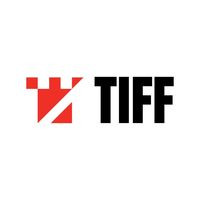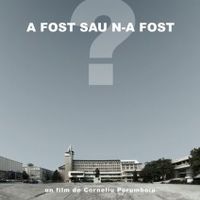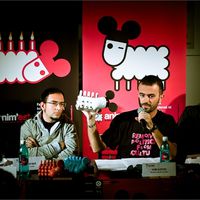Independent theater in the red carpet world
 In 2010 I was given the responsibility of implementing the project Theater at the Transylvania International Film Festival (TIFF) where I had the opportunity to collaborate with the biggest and most well recognized festival in Romania.
In 2010 I was given the responsibility of implementing the project Theater at the Transylvania International Film Festival (TIFF) where I had the opportunity to collaborate with the biggest and most well recognized festival in Romania.When I received the collaboration proposal from TIFF, many questions came to my mind, for example: Why theater at one of the biggest film festivals in Eastern Europe? What does it bring to the audience in addition to the movie projections? Who does the theatre section address? What is the purpose of the theatre section? In 2011 it was the anniversary edition of TIFF (10 years), and it was decided to create a diverse programme, rich in proposals that the audience wouldn’t expect. When I saw a part of the program I liked the idea very much, and I embraced the concept without finding the answers to all my questions.
[caption id="attachment_13358" align="aligncenter" width="576" caption="Romanian theater performance "Rosia Montana, on physical and political line", directors Gianina Carbunariu, Radu Apostol and Andreea Valean, © Andu Dumitrescu"]
The first class quality of the movies presented over the years at TIFF has brought the festival into the national and international public eye. Cluj-Napoca is the second most important historical and cultural city in Romania and the third most important city economically. Until TIFF, the citizens didn’t have a festival of such a high aesthetical and international quality. It was very well received by both the audience and the authorities. In a short time it has become a success by attracting a public not only from Cluj-Napoca, but also from other cities in Romania and professionals from other countries, becoming a reference for the cinematography world in Eastern Europe.
For the citizens of Cluj-Napoca, the festival is the major event of the year, a moment of intense cultural interaction where they can also socialize among the film stars. There are even some people in the city who take time off from work just to have the opportunity to see many films and to have a good time in the atmosphere of the festival. The public is very diverse, from movie amateurs and those faithful to the festival to those who are interested in glam events - parties, opening/closing gala evenings. Generally the audience of TIFF belongs to the medium or above medium income bracket and is interested in spending their free time wisely.
The festival has evolved very much in the last ten years and has contributed to the way that Romanian cinematography is viewed internationally, with a section that is especially dedicated to Romanian directors. It also makes a contribution locally by developing a real movie audience in Transylvania. TIFF is an occasion for the Romanian movie world to meet, as they don’t have this opportunity in Bucharest where 99% of the movie industry has its activity. Practical, Cluj-Napoca is the right place for a ten day vacation for the Romanian cinematography industry and film-lovers, and is a good opportunity for the local economy to show off, to recognize the status of some of the local personalities and to highlight the life quality of the city.
Other events in the festival, like conferences, lectures, workshops and DVD launches, are necessary in order to have a wide dimension of the festival and to give it the right depth through moments of reflection together with industry specialists and the public.
[caption id="attachment_13362" align="alignright" width="342" caption=""Herbert Dream", compagnie Quidams, France"]
 [/caption]
[/caption]After our experiences in the most recent TIFF in June 2011, the question about the necessity of a theater section during a film festival comes again through my mind. In general the public has reacted positively to the development of the festival. The people of Cluj-Napoca are happy to have more events to choose from because, in a period of crisis, the abundance reminds them of the well-being from the near past. The problem comes when we realize that the current audience is too small to absorb all the quality events that are simultaneously organized. The danger for TIFF is to become a self–devouring festival in its wish to cover a wide offering of quality activities for a wide audience. Personally I stand for diversity in the programming, for winning over different types of public, but I think we need to give time for audiences to assimilate this diversity.
The majority of the invited theater performances were mostly independent productions, made with big financial investments on behalf of the organizers and the artists. The world they come from is very different from the red carpet world represented by the big stars who were invited to the film festival, a world in which many dream to live the high life of parties and fun times during the festival. I notice here an inconsistency that was not helpful for the theater section. For example, the main themes represented in the theatre works, most of them social ones, don’t suit very well the glittering ceremonies in the festival.
How much are these theatre performances needed? Who needs these events? If the public that comes to the movies partially overlaps the public that generally goes to the theater, shouldn’t the theatre section instead point to an audience that doesn’t go to either cinemas or theaters? Maybe the theater presented as part of the TIFF programme should instead go to the streets and speak to everyone, not only to the well-established TIFF public. I think that one of the logical changes to the theatre section, if this would still exist in the future, would be to put it outside the limiting safety net of the established theater and film audiences by taking the theatre to the people and thereby expanding the audience of TIFF.
Miki Braniste is cultural manager lives and works in Cluj and Bucharest, Romania. She was the initiator of the eXplore dance festival in 2005, Bucharest and from 2008 she is the director of the interdisciplinary festival TEMPS D'IMAGES in Cluj organized by Colectiv A Association. She is also member of the board of the contemporary art space The Paintbrush Factory in Cluj, the first reconverted industrial building in Romania. Miki is also visiting teacher in cultural management for students from the cultural field.
Similar content
posted on
28 Nov 2016
deadline
15 Mar 2013
By Kerrine Goh
25 Jun 2007
from - to
31 May 2013 - 09 Jun 2013
02 Nov 2010





